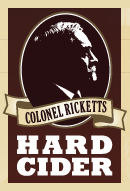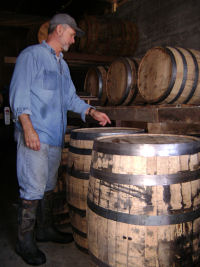Cider tour

Pennsylvania apples
We buy our apples from orchards here in Columbia and neighboring counties.
Varieties include Macintosh, Stayman, Fuji, Cortland, Gala, and Red and Golden Delicious.
By mixing varieties in differing amounts we can produce ciders with distinctive qualities and flavor.
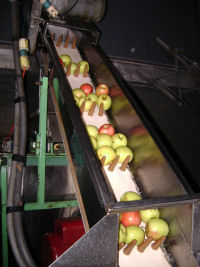
Sort, wash & crush
Prior to pressing we sort out apples with bad spots, leaving the best apples for cider.
Next, the apples pass through the brush washer, up the conveyor and into the grinder, where they're ground into pommage.
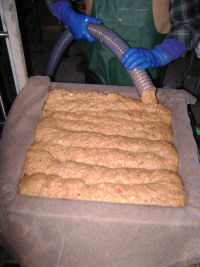
Filling the press
On the press we fill a rack of trays 7 layers deep with pommage from the crusher.
Each layer is wrapped in a special pressure–resistant cloth that allows just the cider juices to escape during pressing.

Pressing
Pressing takes about 15 minutes. We pressurize the rack to 23,000 psi. During this time, virtually all juice is squeezed from the pommage.
As the juice flows out of the trays, it drains to a reservoir, then is pumped to a stainless steel storage tank.
In one day we produce about 130 gallons of cider from 40 bushels of apples.

Pommage
Each pommage layer weighs about 2.5 lbs after pressing.
We save these leftovers for local farmers who feed them to their pigs.

Fermentation & aging
The cider at this point – prior to fermentation – can be sold as sweet or traditional apple cider.
To produce hard cider, we first filter the sweet cider, then transfer it to 55–gallon oak barrels and add sugar, yeast and salicylic acid.
The yeast jumpstarts the fermentation process, during which the sugar is converted to alcohol. The salicyclic acid prevents sediment from forming and ensures a clear finished product.
The barrels are capped with a percolating aeration system that prevents outside bacteria from entering. The system also allows gases created from the production of alcohol to escape.
The barrels are kept at a controlled temperature and humidity for up to a year.
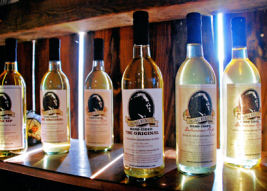
Filtering & bottling
We bottle our finished hard cider – also known as apple table wine – at its peak of flavor.
Prior to bottling, we filter the fermented cider 3 times. This removes all suspended particles, making the cider as clear as possible.
Our 2 stages of filtering – the original sweet cider, as well as the finished hard cider – ensures the purest hard cider possible from our ciderworks.
